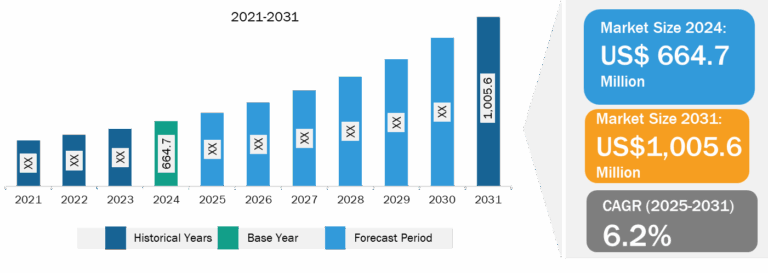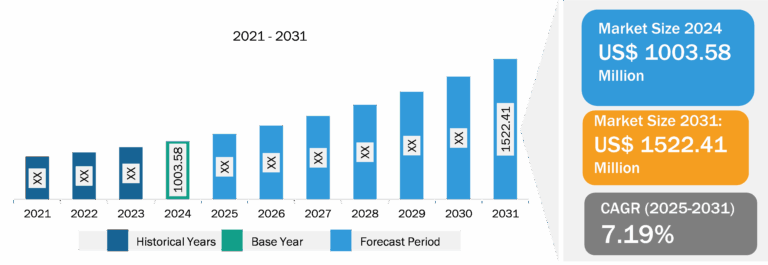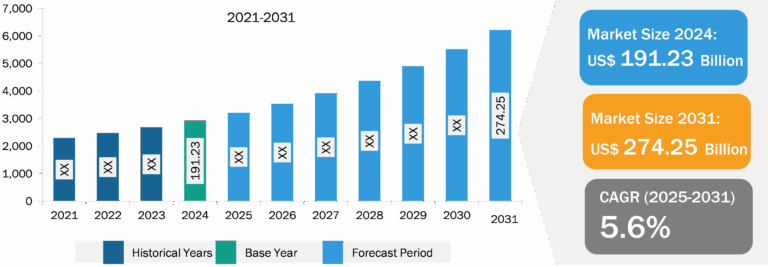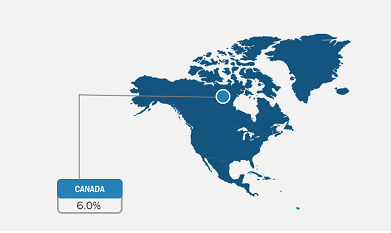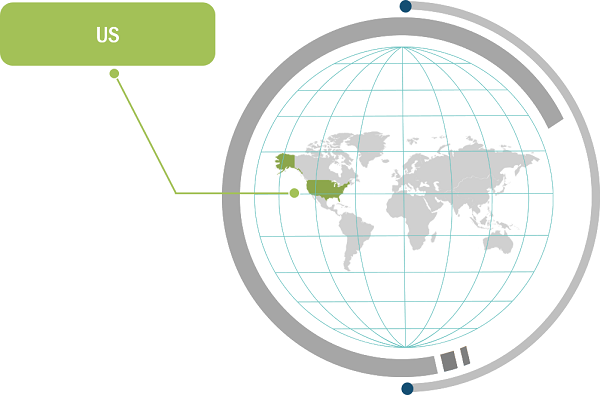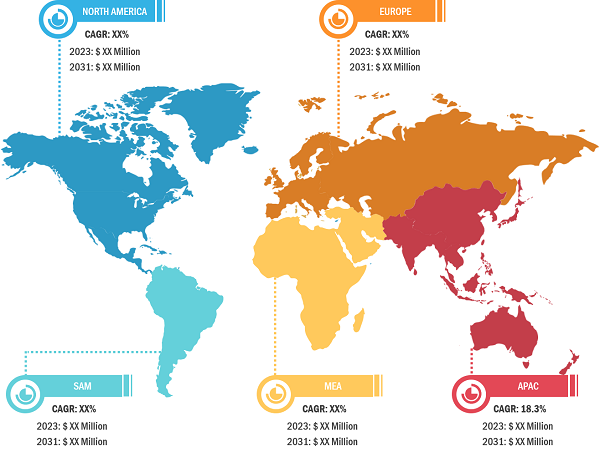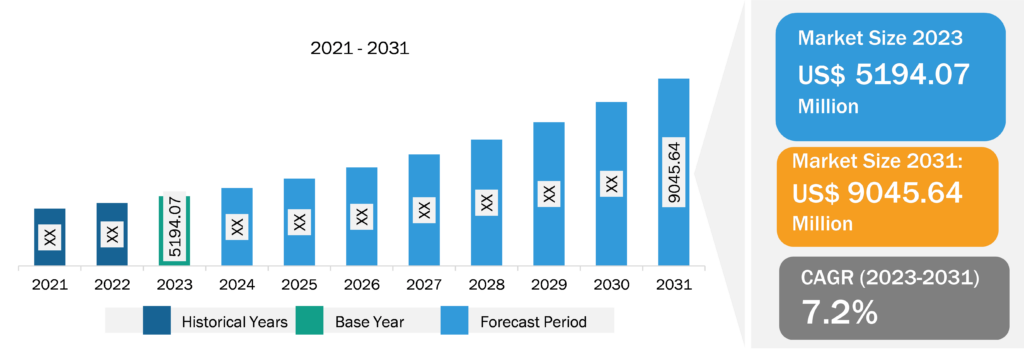
Recirculating Aquaculture System Market
According to a new comprehensive report from The Insight Partners, the global recirculating aquaculture system market is observing significant growth owing to the increasing demand for seafood.
The report runs an in-depth analysis of market trends, key players, and future opportunities. Types of prominent recirculating aquaculture system components include filtration systems, aeration systems, and pumping systems. Aquaculture system manufacturers procure specific grades of materials from raw material suppliers and process them further to develop the final product.

Overview of Report Findings
- Market Growth: The recirculating aquaculture system market is expected to reach US$ 9,045.64 million by 2031 from US$ 5,194.07 million in 2023 at a CAGR of 7.2%. Apart from the high efficiency of the recirculating aquaculture system, increasing demand for seafood is another factor that is driving the demand for the recirculating aquaculture systems. According to the data published by the US Department of Agriculture in 2021, the per capita seafood consumption in 2021 in the US was approximately 17 pounds, which further rose to 20 pounds in 2021. As per the State of World Fisheries and Aquaculture (SOFIA), global fisheries and aquaculture production in 2022 reached 223.2 million tons, indicating a 44% hike from 2020. The growing demand for seafood has led to increased research and development activities to develop efficient recirculating aquaculture technology. For instance, in April 2024, the US Department of Agriculture Agricultural Research Service (USDA-ARS) awarded the Aquaculture Research Institute US$ 2.25 million for research on recirculating aquaculture systems for different types of seafood species.
- Research and Development Activities: Recirculating aquaculture systems are being explored for improvements in their scalability and flexibility. As the technology matures, it is likely to become easier to adapt these systems to a variety of scales and species, from small, local operations to large, industrial-scale farms. They can also be customized to meet the needs of different fish species, from freshwater species such as tilapia to saltwater species such as salmon and sea bass. This flexibility makes recirculating aquaculture a viable option for a broader range of aquaculture markets, both in terms of species diversity and location feasibility. Thus, ongoing developments in recirculating aquaculture are pivotal to the growth of the recirculating aquaculture systems market. These developments are expected to further enhance the appeal and availability of these systems to a broader pool of consumers and aquaculture producers.
- Integration of Automation and AI: The integration of automation and artificial intelligence (AI) is expected to emerge as one of the key trends driving the future of recirculating aquaculture systems technology in the near future. These technologies are enhancing the efficiency, sustainability, and scalability of these modern-age operations, bringing an overall revolution in the way aquaculture is managed. The integration of automation with recirculating aquaculture technology allows for more precise control over environmental variables such as water quality, temperature, pH, and oxygen levels. Automated sensors and monitoring systems can continuously track these factors in real time, adjusting systems accordingly to ensure optimal conditions for fish health and growth. Automated feeders can adjust feeding schedules based on fish behavior and demand. At the same time, water filtration systems can operate with minimal human intervention, reducing labor costs and improving operational efficiency. This level of automation minimizes the need for manual labor, allowing fish farms to operate more efficiently while lowering overall operating costs. Several companies offer innovative solutions for water quality monitoring, feed management, and environmental control, leveraging AI to analyze real-time data and predict system needs. Companies such as AKVA Group and Aquabyte utilize machine learning algorithms and automated sensors to enhance fish health monitoring, reduce waste, and improve overall system performance. The integration of automation and AI into modern aquaculture is set to transform it by aiding in improved efficiency, sustainability, and scalability.
- Geographical Insights: In 2023, Asia Pacific led the market with a substantial revenue share, followed by North America and Europe. Asia Pacific is expected to register the highest CAGR during the forecast period.
Market Segmentation
- Based on offering, the recirculating aquaculture system market is bifurcated into components and services. The components segment dominated the market in 2023. The component category is further divided into filtration systems, aeration systems, pumping systems, and others.
- By fishery capacity, the recirculating aquaculture system market is categorized into small scale (upto 20,000 liters), medium scale (21,000–50,000 liters), and large scale (above 50,000 liters). The large scale (above 50,000 liters) segment held the largest share of the market in 2023.
- The recirculating aquaculture system market is segmented into five major regions: North America, Europe, APAC, Middle East & Africa, and South America.
Competitive Strategy and Development
- Key Players: A few major companies operating in the recirculating aquaculture system market are Innovasea Systems Inc.; MAT-KULING RECIRCULATING AQUACULTURE SYSTEMS; PR Aqua; ULC, Integrated Aqua Systems, Inc; AquaMaof Aquaculture Technologies Ltd.; Veolia Environnement SA; FutureFish Aquaculture GmbH; AKVA Group ASA; Xylem Inc.; and Aquavet Solutions Limited.
- Trending Topics: Aquaculture, aquaponics, etc.
Global Headlines on Recirculating Aquaculture System
- AKVA Group announced a new contract with Laxey to advance land-based aquaculture technology in the Westman Islands, Iceland.
- MAT-KULING confirms its focus on the fast-developing recirculating aquaculture solution (RAS) market in Asia in collaboration with Wonjin Fisheries Co.Ltd. in South Korea.
Conclusion
The recirculating aquaculture systems market is witnessing significant growth across various regions owing to the increasing demand for sustainably sourced seafood, inclination toward technological advancements, and a burgeoning focus on environmentally friendly practices. According to the 2024 edition of the State of World Fisheries and Aquaculture (SOFIA) report by the Food and Agriculture Organization (FAO), global fisheries and aquaculture production peaked in 2022, surpassing 223.2 million tonnes. This rise marked a 4.4% increase from the levels recorded in 2020. Notably, for the first time in history, aquaculture production of aquatic animals exceeded that of capture fisheries, accounting for 185.4 million tonnes of aquatic animals and 37.8 million tonnes of algae. This milestone underlines the growing role of aquaculture in the global seafood supply chain. It also highlights the increasing adoption of sustainable aquaculture practices, such as recirculating aquaculture systems, which are becoming crucial in meeting the rising demand for seafood. The recirculating aquaculture systems market is developing in the Middle East and Africa as the countries focus on finding ways to ensure sustainable seafood production while addressing water scarcity and food security concerns. Egypt and Saudi Arabia are key countries in the market in this region, with Egypt’s aquaculture sector seeing significant growth. The establishment of Aquaculture Middle East Network (AQMENET), which includes countries such as Saudi Arabia, Kuwait, and Jordan, has facilitated collaboration on improving aquaculture practices, which benefits the recirculating aquaculture systems market.
The report from The Insight Partners, therefore, provides several stakeholders—including raw material providers, manufacturers, suppliers and distributors, and end users—with valuable insights into how to successfully navigate this evolving market landscape and unlock new opportunities.

